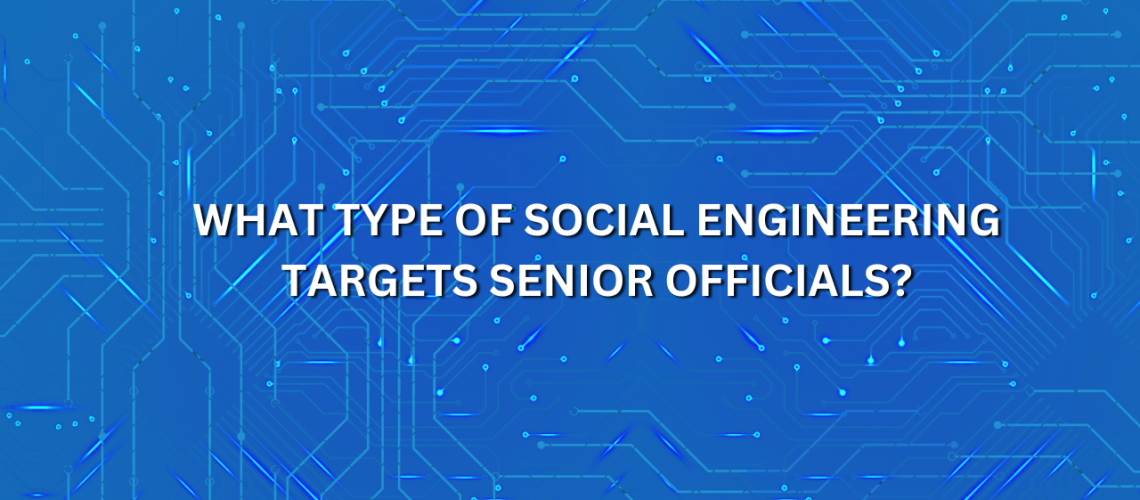In today’s interconnected world, where information is power, cyberattacks have become increasingly sophisticated. Among the most insidious methods employed by malicious actors is social engineering, a psychological manipulation technique used to deceive individuals into divulging sensitive information or taking specific actions. Senior officials, with their access to valuable data and decision-making authority, are prime targets for social engineering attacks. In this comprehensive guide, we delve into the various types of social engineering tactics that malicious actors employ to target senior officials and how organizations can mitigate these risks effectively.
1. Phishing
Phishing remains one of the most prevalent forms of social engineering attacks targeting senior officials. Malicious actors craft emails, messages, or even phone calls designed to appear legitimate, often impersonating trusted entities such as colleagues, vendors, or government agencies. These communications typically contain urgent requests for sensitive information or prompt recipients to click on malicious links or download infected attachments. Senior officials, busy and frequently inundated with communications, may inadvertently fall prey to these deceptive tactics, compromising sensitive data or granting access to corporate networks.
2. Spear Phishing
Spear phishing takes the concept of phishing a step further by customizing attacks to specific individuals or organizations. Malicious actors conduct extensive research on their targets, gathering information from social media, corporate websites, and other publicly available sources to tailor their communications. By personalizing messages with relevant details, such as the target’s name, job title, or recent activities, spear phishing attacks can appear highly convincing and difficult to detect. Senior officials, with their prominent roles and access to valuable information, are particularly vulnerable to these targeted attacks.
Also Read: 2024 Cybersecurity Experts Predictions: Future of Digital Defense
3. CEO Fraud or Business Email Compromise (BEC)
CEO fraud, also known as business email compromise (BEC), involves impersonating high-ranking executives within an organization to deceive employees into transferring funds or sensitive information. Senior officials, including CEOs, CFOs, and other executives, are often the primary targets of these attacks due to their authority and access to financial resources. Malicious actors may use spoofed email addresses or compromised accounts to initiate fraudulent wire transfers, invoice payments, or other financial transactions, resulting in significant financial losses for organizations.
4. Pretexting
Pretexting involves creating a fabricated scenario or pretext to manipulate individuals into disclosing sensitive information or performing specific actions. Malicious actors may impersonate trusted individuals, such as IT personnel, government officials, or law enforcement officers, to gain the trust of their targets. Senior officials, with their responsibilities for organizational security and compliance, may be targeted with pretexting tactics aimed at extracting sensitive information, such as login credentials, financial data, or proprietary business intelligence.
5. Impersonation
Impersonation attacks involve masquerading as legitimate individuals or entities to deceive targets into taking specific actions. Malicious actors may impersonate senior officials, colleagues, or trusted vendors to gain access to sensitive information or corporate resources. These attacks often exploit trust relationships within organizations, leveraging familiarity and authority to manipulate targets into complying with fraudulent requests. Senior officials, with their visibility and influence within organizations, may be prime targets for impersonation attacks seeking to exploit their positions of authority.
Mitigating the Risks
Given the prevalence and sophistication of social engineering attacks targeting senior officials, organizations must implement robust security measures to mitigate these risks effectively. Some key strategies include:
- Employee Training and Awareness: Educate senior officials and employees about the various types of social engineering tactics, warning signs of potential attacks, and best practices for identifying and responding to suspicious communications.
- Multi-Factor Authentication (MFA): Implement multi-factor authentication mechanisms to enhance the security of sensitive accounts and systems, reducing the risk of unauthorized access resulting from compromised credentials.
- Email Filtering and Security Solutions: Deploy email filtering and security solutions capable of detecting and blocking phishing attempts, malicious attachments, and suspicious links before they reach recipients’ inboxes.
- Regular Security Assessments: Conduct regular security assessments, including penetration testing and vulnerability scanning, to identify and address potential weaknesses in organizational defenses and processes.
- Incident Response Planning: Develop comprehensive incident response plans outlining procedures for detecting, containing, and mitigating the impact of social engineering attacks. Ensure that senior officials and relevant stakeholders are aware of their roles and responsibilities in responding to security incidents effectively.
By implementing these proactive measures and fostering a culture of cybersecurity awareness within organizations, senior officials can better protect themselves and their organizations from the pervasive threat of social engineering attacks. In an increasingly interconnected and digitally dependent world, vigilance and preparedness are paramount to staying one step ahead of malicious actors and safeguarding sensitive information and assets.



